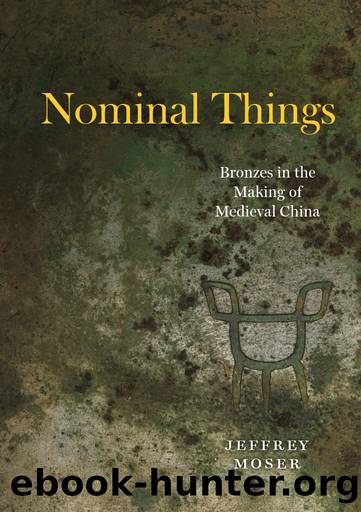Nominal Things: Bronzes in the Making of Medieval China by Jeffrey Moser

Author:Jeffrey Moser [Moser, Jeffrey]
Language: eng
Format: epub
Tags: ART000000 ART / General, ART019010 ART / Asian / Chinese, ART015070 ART / History / Medieval, LAN016000 LANGUAGE ARTS & DISCIPLINES / Linguistics / Semantics
Publisher: University of Chicago Press
Published: 2023-03-30T00:00:00+00:00
5
Nominal Empiricism
In the years following the correspondence between Ouyang Xiu and Liu Chang, the circle of those involved in the collecting of antiquities expanded. Records indicate that by the 1090s, at least forty literati, representing all major regions of the Song empire, were not only collecting antiquities, but actively deciphering their inscriptions, drawing pictures of them, and exchanging what they learned with one another.1 There were doubtless many others.
One of these collectors was the Hanlin academician Shen Gua (1031â1095). A polymath who kept careful notes of his observations of natural and man-made phenomena, Shen wrote on everything from engineering and finance to divination and painting.2 At one point in his career (the precise dates are uncertain), Shen traveled to the antiquities-rich region surrounding the former capital of Changâan, where Liu Chang, a generation earlier, had commenced his collection and study of ancient bronzes. There he acquired a âan ancient bronze yellow yi vesselâ (gu tong huang yi). Shen was familiar with the image of the yellow yi from the reconstructions of Nie Chongyi. But the bronze vessel in his hands did not look anything like the vessel in those pictures:
The âyellow yiâ recorded in ritual books is decorated with the painted image of human eyes, which are called âyellow eyes.â When I was traveling in Guanzhong, I obtained an ancient bronze yellow yi which was completely different. It was incised with complex designs that, on the whole, resembled âtwisted official scriptâ (jiu zhuan shu) and the breaking waves painted on the panels of balustrades. Within these patterns were two eyes, like large slingshot pellets, bulging. Gleaming (huang huang), they were the so-called âyellow (huang) eyes.â Upon examining the design, it appeared to represent fangs and horns and a gaping maw. Perhaps one could say that âyellow eyesâ refers to none other than this thing.3
Download
This site does not store any files on its server. We only index and link to content provided by other sites. Please contact the content providers to delete copyright contents if any and email us, we'll remove relevant links or contents immediately.
Cecilia; Or, Memoirs of an Heiress — Volume 1 by Fanny Burney(31351)
Cecilia; Or, Memoirs of an Heiress — Volume 3 by Fanny Burney(30948)
Cecilia; Or, Memoirs of an Heiress — Volume 2 by Fanny Burney(30907)
The Lost Art of Listening by Michael P. Nichols(6481)
We Need to Talk by Celeste Headlee(4879)
Asking the Right Questions: A Guide to Critical Thinking by M. Neil Browne & Stuart M. Keeley(4599)
On Writing A Memoir of the Craft by Stephen King(4221)
Dialogue by Robert McKee(3592)
I Have Something to Say: Mastering the Art of Public Speaking in an Age of Disconnection by John Bowe(3520)
Pre-Suasion: A Revolutionary Way to Influence and Persuade by Robert Cialdini(3422)
Elements of Style 2017 by Richard De A'Morelli(2946)
The Book of Human Emotions by Tiffany Watt Smith(2779)
Good Humor, Bad Taste: A Sociology of the Joke by Kuipers Giselinde(2559)
Name Book, The: Over 10,000 Names--Their Meanings, Origins, and Spiritual Significance by Astoria Dorothy(2495)
Fluent Forever: How to Learn Any Language Fast and Never Forget It by Gabriel Wyner(2450)
The Grammaring Guide to English Grammar with Exercises by Péter Simon(2397)
Why I Write by George Orwell(2362)
The Art Of Deception by Kevin Mitnick(2302)
Don't Sleep, There Are Snakes by Daniel L. Everett(2220)
